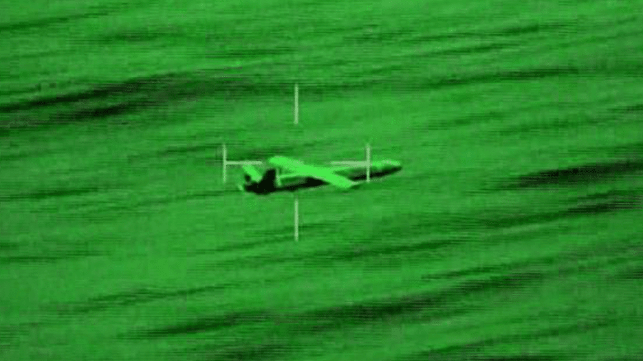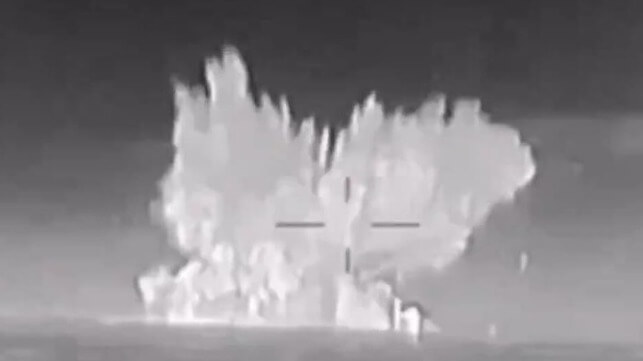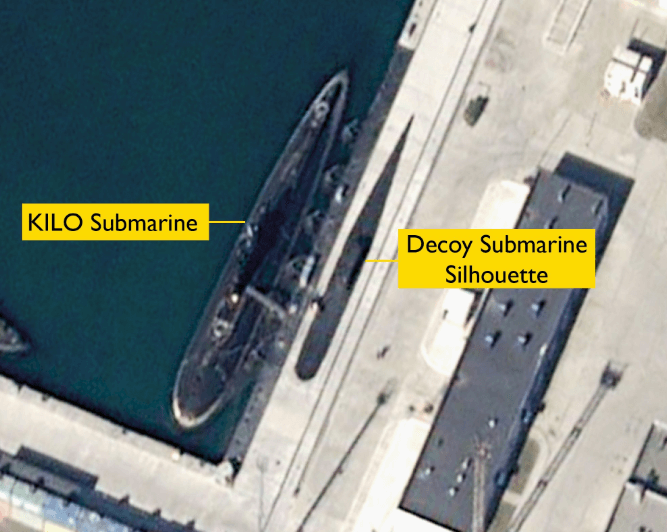THE LATEST WEAPONS SHOW
Video: French Navy Helicopter Shoots Down a Houthi Drone

Houthi suicide drones are imposing a high cost on Western navies in the Red Sea - not because any of the group's munitions have hit a government vessel, but because of the multimillion-dollar expense of shooting them down. This week, a French frigate demonstrated a more cost-effective approach to defeating low-and-slow drone attacks: a helicopter chase.
In a video released by France's defense ministry, a helicopter from an unnamed French frigate tracked a slow-moving Houthi drone as it entered the shipping lanes of the Red Sea. While not shown, the audio suggests that the aircrew's door gunner shot the UAV down.
At a cost per round of about $0.50-1.00, plus the $5-10,000 hourly operating cost of the helicopter, the price of downing the drone was far less than what it would have been with the Aster air-defense missiles carried by the same frigate. This is not hypothetical: a French warship recently used a multi-million-dollar Aster to destroy a drone within visual range, below. (The crew also had an opportunity to take down a drone with the main deck gun, a less expensive but dangerously close engagement.)
France is participating in the Red Sea air defense mission under the auspices of the EU's Operation Aspides, a strictly defensive coalition under a separate command structure from the U.S.-led Operation Prosperity Guardian.
Russia's Black Sea Fleet Takes New Measures to Fend Off Ukraine's Drones

Ukraine's successful campaign of attacks on the Russian Black Sea Fleet has attracted attention at the highest levels of Russia's military establishment. On March 17, defense minister Sergei Shoigu personally visited the Black Sea Fleet's command post in Crimea to discuss measures to protect the fleet's remaining warships. About 15 Russian naval vessels have been damaged or destroyed by Ukraine's drones and missiles since the start of the full-scale invasion in 2022.
According to UK intelligence, Shoigu instructed the Black Sea Fleet's leadership to conduct daily exercises on defending against unmanned bomb boats. He ordered the installation of extra defensive weapons on unspecified vessels to help fend off the new high-tech threat.
Ukraine's suicide drone boats have sunk two warships in a month's time, penetrating past defensive machine gun and cannon fire with relative ease. Their operators attack at night, aiming at the stern to disable propulsion with the first wave, then striking the vessel repeatedly amidships in order to initiate flooding and capsizing. Videos released by Ukrainian military intelligence appear to show that once the target vessel has been hit and immobilized, the drones' remote operators attempt to physically maneuver the devices into the interior of the ship - through previous blast holes at the waterline - before detonating their explosive payload.
"The Russian Navy has highly likely resorted to limiting its operations to the eastern Black sea as its losses mount and its threat perceptions increase," said UK Defence Intelligence in an assessment Tuesday. "With Ukraine continuing to seek out opportunities to strike at a distance, he Russian Ministry of Defence has been prompted to increase its efforts to preserve its fleet in the Black Sea."
Other measures include new "maskirovka" (deception and camouflage) efforts. The Russian Navy has repainted the bows and sterns of many of its Black Sea warships in black paint, hoping to make them look like smaller vessels and reduce the "visible" target area. This approach has a rough parallel in the "dazzle paint" schemes used by Allied vessels in the Second World War. However, open-source analysts in the West have noted that the paint scheme has no effect on infrared camera targeting, as used by Ukrainian forces.
UK intelligence has also spotted decoy silhouettes of ships and submarines painted onto the quayside next to real vessels at Russian naval bases, perhaps in an attempt to confuse Ukrainian aerial drone opertors. "It is unlikely that the use of maskirovka techniques will lead to any significant reduction in losses," assessed the department.

Courtesy UK MOD
No comments:
Post a Comment